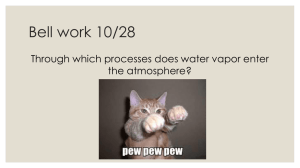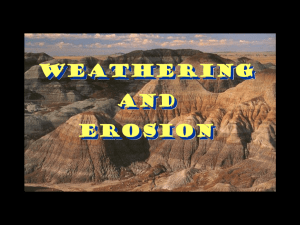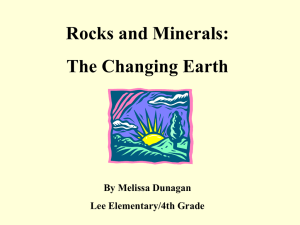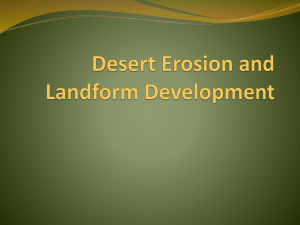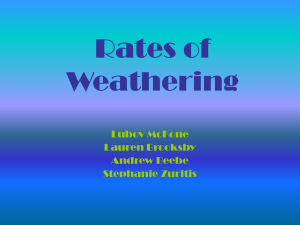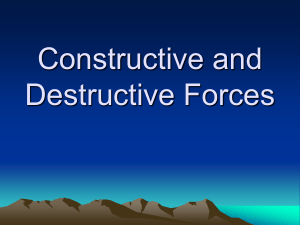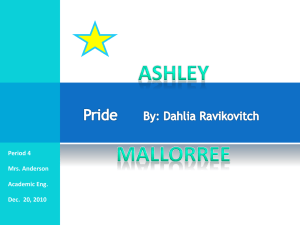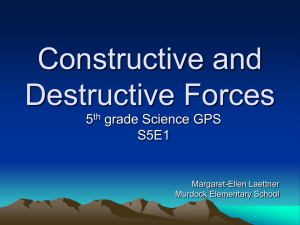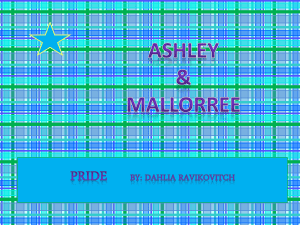start weathering & erosion notes
advertisement
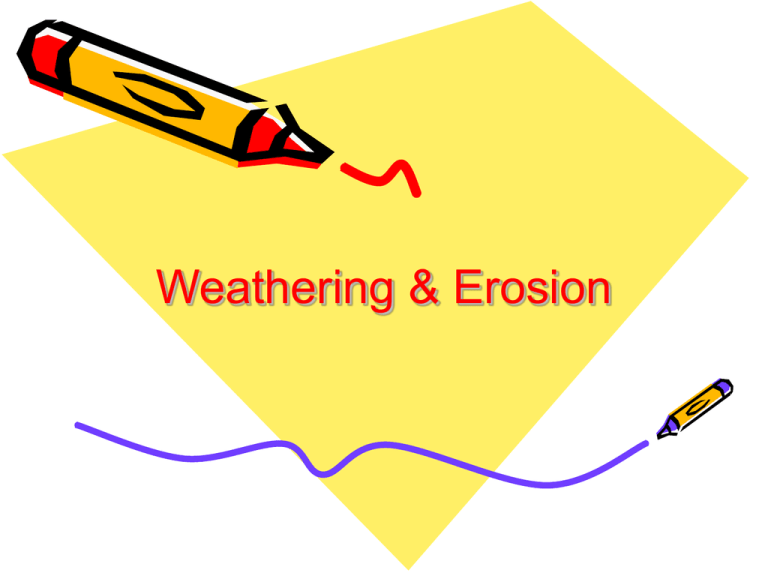
Weathering & Erosion Blue foldable • Outside: Weathering • Inside: The break down of rock into smaller and smaller pieces – Forms sediment – Happens to rocks that are not moving Blue: Two Flaps • Chemical • Mechanical or physical Blue flap: Mechanical or Physical Weathering • Inside: – Breakdown of rock by physical means – Just changes the look of the rock Blue flap: Chemical Weathering • Inside: – Breakdown of rock by chemical means – Forms a new substance Green foldable: • Outside: Agents of Mechanical Weathering • Inside on flaps: – – – – – – Ice Wind Water Gravity Plants Animals On inside of Agents of weathering foldable • Abrasion: rocks grind against each other and wear away their surface – Rocks rub together in streams – Chalk on chalkboard • Ice: – inside: Ice wedging: water freezes in cracks. When it expands, the crack gets bigger. • Wind: – Inside: wind forces rocks into each other • Water: – Inside: rivers and streams roll rocks into each other • Gravity: – Inside: gravity pulls rocks down into each other • Ex: rock slide • Plants: – Inside: roots break apart rock • Animals: – Inside: Animals that dig break apart rocks Pink foldable: • Outside: Agents of Chemical Weathering • Inside on flaps: – Water – Acid rain – Lichens – Air • Water: – Inside: water can eat away certain types of rocks & minerals • Acid rain: – Inside: acids in rain causes rocks to change • Lichens: – Inside: plants that give off acid & eat away rocks • Air: – Inside: air causes oxidation – Oxidation: oxygen in air react with another element to form an oxide • Creates rust Gold foldable • Outside: Differential weathering • Inside: Process where softer, less weather resistant rocks wears away leaving harder rock behind. Yellow Foldable • Outside: 4 things that affect the rate of weathering • Inside on flaps: – Hardness of rock – Surface area exposed – Climate – Elevation • Hardness of rock: – Inside: harder rocks weather slower than soft rocks • Surface area exposed: – Inside: smaller rocks weather faster than larger rocks • Climate: – Inside: oxidation occurs more in warm, wet climates • Elevation: – Inside: rocks at higher elevations are exposed to more water and wind -> more weathering – Steeper mountains cause more weathering Purple Foldable: • Outside on 1st flap: Erosion – Inside: the transport of sediments from one place to another • Outside on 2nd flap: Deposition -Inside: when sediments are dropped off White Foldable: • Outside: Agents of Erosion & Deposition • On flaps: – – – – Water Wind Ice Gravity Water: Inside: moves sand &small rocks and deposits them in a new location Wind: Inside: moves sand and small rocks and deposits them in new locations Ice: Inside: Ice moves sand and all kinds of rocks to new locations Gravity: Inside: sediments move downhill Salmon Foldable: • Outside: Landforms created by weathering, erosion, & deposition Inside labels: - Green = wind - Pink = Gravity - Yellow = Ice - Blue = Waves Landforms made by wind • Sand Dunes Landforms made by Gravity: rock falls, landslides QuickTime™ and a TIFF (Uncompressed) decompressor are needed to see this picture. • Landforms made by Ice: Glue in whole white picture Landforms created by waves • Sea stack QuickTime™ and a TIFF (Uncompressed) decompressor are needed to see this picture. Sea arch QuickTime™ and a TIFF (Uncompressed) decompressor are needed to see this picture. • Beaches • Sandbars • Barrier spit Quic kT ime™ and a T IFF (Uncompres sed) decompres sor are needed to s ee this pict ure. QuickTime™ and a TIFF (Uncompressed) decompressor are needed to see this picture. • Sea cliff Quick Time™ an d a TIFF ( Un compr ess ed) de compr ess or ar e n eed ed to s ee this pic ture . • Wave cut terrace • Headlands Qui ckTime™ and a TIFF (Uncompressed) decompressor are needed to see this pictur e. Quick Time™ an d a TIFF ( Un compr ess ed) de compr ess or ar e n eed ed to s ee this pic ture . Quick Time™ an d a TIFF ( Un compr ess ed) de compr ess or ar e n eed ed to s ee this pic ture . Qui ckTime™ and a TIFF (Uncompressed) decompressor are needed to see this pictur e.
